Wai-Fah Chen.The Civil Engineering Handbook
Подождите немного. Документ загружается.


53-22 The Civil Engineering Handbook, Second Edition
where
(53.97)
Equation (53.96) is called the characteristic equation of A, or the eigenvalue equation. The matrix (A – lI)
is called the characteristic matrix. There are n roots for Eq. (53.96), counting multiplicity. These are the
n eigenvalues of A, l
1
, l
2
, …, l
n
. For an eigenvalue l
i
, we solve the set of (homogeneous) linear equations
(A – l
i
I)x = 0 to determine the components of the corresponding eigenvector x
i
. In general, l
i
and x
i
are either real or complex numbers and vectors, respectively.
If the matrix A is symmetric, then:
1. The eigenvalues are real.
2. The eigenvectors are all mutually orthogonal; that is,
Bilinear and Quadratic Forms
If A is a square matrix of order n and x and y are two arbitrary n vectors, then the scalar
(53.98)
is called a bilinear form. If, however, the matrix A is also symmetric, then
(53.99)
is called a quadratic form with the kernel A.
The matrix A is called positive definite if v > 0 for all x π 0, and we write A > 0. If v ≥ 0 for all x and
there exists a nonzero vector x for which equality holds, we say A is positive semidefinite (or nonnegative
definite) and write A ≥ 0. There are corresponding definitions for negative definite (or nonpositive definite).
If there exist vectors x
1
and x
2
such that x
T
1
Ax
1
> 0 and x
T
2
Ax
2
< 0, we say A is indefinite.
For a positive definite matrix A it is necessary and sufficient that
A quadratic form represents, in general, a conic section of some kind. Considering the two-dimen-
sional case for simplicity, we write
(53.100)
or
which is the equation of an ellipse.
b
n
1=
b
n 1–
a
11
a
22
L a
nn
+++ a
ii
i 1=
n
Â
tr A() trace of A====
M
b
nr–
sum of all principal minors of order r of A=
M
b
0
A determinant of A==
x
i
T
x
j
x
j
T
x
i
0==
u x
T
Ay=
v x
T
Ax=
a
11
0
a
11
a
12
a
21
a
22
0 L A 0>,,>,>
x
T
Ax b with A symmetric=
a
11
x
1
2
2a
12
x
1
x
2
a
22
x
2
2
++b=
© 2003 by CRC Press LLC

General Mathematical and Physical Concepts 53-23
53.6 Coordinate Transformations
Linear Transformations
A general linear transformation of a vector x to another vector y takes the form
(53.101)
Each element of the y vector is a linear combination of the elements of x plus a translation or shift
represented by an element of the t vector. The matrix M is called the transformation matrix, which is in
general rectangular, and t is called the translation vector. For our use we restrict M to being square
nonsingular; thus, the inverse relation exists, or
(53.102)
in which case it is called affine transformation. Although both Eqs. (53.101) and (53.102) apply to higher-
dimension vectors, we will limit our discussions, without loss of generality, to the more practical two-
and three-dimensional spaces, where the elements of the transformations can be depicted geometrically.
Two-Dimensional Linear Transformations
There are six elementary transformations, each representing a single effect, which are geometrically
represented in Fig. 53.3. Initially, four vectors (1,3) (1,5), (3,3) (3,5) representing the corners of a square
(solid lines in Fig. 53.3) are referred to the x
1
, x
2
coordinate system. Each of the six elementary transfor-
mations operates on the square, and the resulting y
1
, y
2
coordinates are plotted to show the effect on the
location, orientation, size, and shape of the square after the transformation (dashed lines in Fig. 53.3).
In displaying the effects of the transformations, we either display the new figure (dashed lines) in the
same coordinate system, or we change the coordinate system. It is easier for the student to visualize these
transformations if the new figure is drawn without changing the coordinate system, which we did in
Fig. 53.3. However, as we discuss each elementary transformation, we will comment on the second
interpretation when appropriate.
1. Translation
(53.103)
The square is shifted 3 units in x
1
direction and 1 unit in x
2
direction, as shown in Fig. 53.3(a).
Alternatively, the solid square remains and the coordinate axes shifted (in the opposite direction
and shown in dashed lines).
2. Uniform Scale
(53.104)
The (dotted) square is enlarged by the uniform scale u (= 1.5 in Fig. 53.3(b)), which results from
all four point coordinate pairs multiplied by u. Alternatively, the solid square is referred to the same
coordinate system, except that the units along the axes are now 1/u of the original units.
3. Rotation
(53.105)
yMxt+=
xM
1–
yt–()=
yxt where M+ I==
yMx M U
u 0
0 u
uI====
yMx MR
b
cos
b
sin
b
sin–
b
cos
===
© 2003 by CRC Press LLC
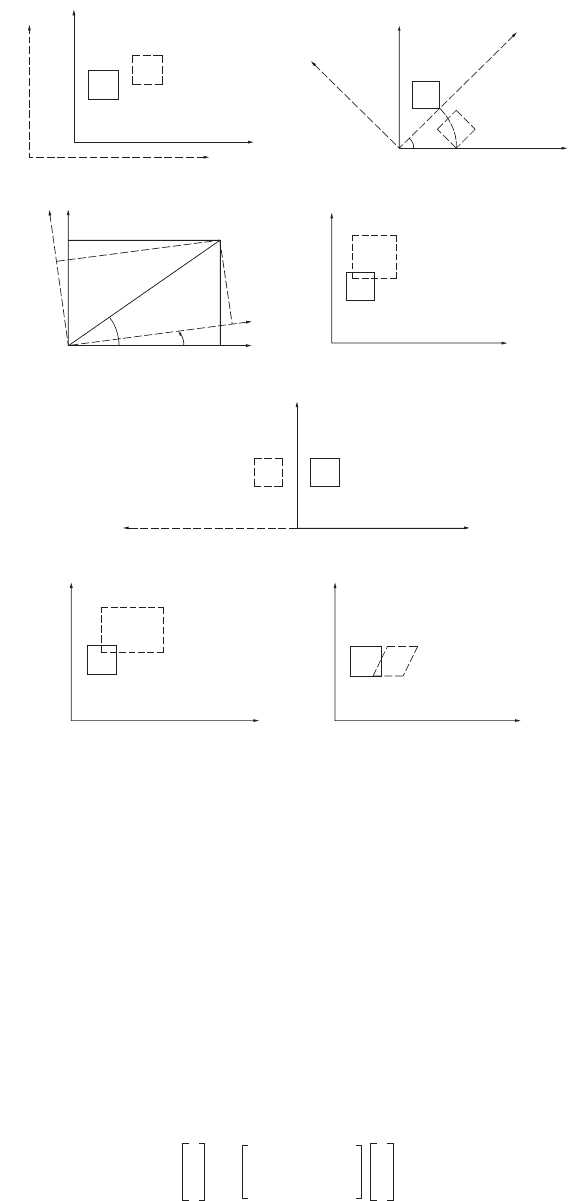
53-24 The Civil Engineering Handbook, Second Edition
The square retains its shape, but is rotated through b about the origin of the coordinate system.
In Fig. 53.3(c), the coordinate system is also rotated (45˚). The elements of R are derived from
Fig. 53.3(d) as follows:
or
or
(53.106)
FIGURE 53.3 (a) Translation. (b) Uniform scale. (c) Rotation. (d) Rotation of a two-dimensional coordinate system.
(e) Reflection. (f) Stretch (nonuniform scale). (g) Skew (nonperpendicularity of axes).
(a) (c)
(d)
(e)
(f)
(g)
(b)
x
2
,
y
2
x
2
,
y
2
x
2
,
y
2
x
2
,
y
2
x
2
,
y
2
x
2
,
y
2
45°
y
2
x
2
x
1
P
y
1
y
2
x
2
y
1
x
1
r
0
Θ
b
x
1
,
y
1
x
1
,
y
1
x
1
,
y
1
x
1
,
y
1
x
1
,
y
1
x
1
,
y
1
y
1
r
qb
–()cos r
qb
r
qb
sinsin+coscos==
y
2
r
qb
–()sin r
qb
r–
qb
sincoscossin==
y
1
x
1
b
cos x
2
b
y
2
x
1
–
b
sin x
2
b
cos+=
sin+=
y
1
y
2
b
cos
b
sin
b
sin–
b
cos
x
1
x
2
=
© 2003 by CRC Press LLC

General Mathematical and Physical Concepts 53-25
The matrix R is proper orthogonal, R
–1
= R
T
and |R| = +1. Rotation matrices do not change the
length of the vector, i.e., |x| = |y|. Considering the square of the vector length,
or
which for a nontrivial solution means that M
T
M = I, thus showing that M is an orthogonal matrix.
4. Reflection
Figure 53.3(e) shows reflection of the x
1
axis (i.e., about the x
2
axis). F is improper orthogonal,
F
–1
= F
T
= F and |F| = –1.
5. Stretch (Two Scale Factors)
(53.107)
The square is transformed into a rectangle as shown in Fig. 53.3(f), in which
6. Skew (Shear)
(53.108)
The square is transformed into a parallelogram as shown in Fig. 53.3(g), where
From these elementary transformations several affine transformations may be constructed using var-
ious sequences. The following are two of the commonly used transformations in photogrammetry.
Four-Parameter Transformation.
(53.109a)
or
(53.109b)
y
T
yMx()
T
Mx x
T
M
T
Mx
T
x
T
x===
x
T
M
T
MI–()x 0=
yMx MF
1– 0
01
===
yMx MS
s
1
0
0 s
2
===
S
2 0
0 1.5
=
yMx MK
1 k
01
===
K
1 0.5
01
=
y
1
y
2
u 0
0 u
b
cos
b
sin
b
sin–
b
cos
x
1
x
2
t
1
t
2
+=
y
1
ux
1
b
ux
2
b
t
1
y
2
u– x
1
b
ux
2
b
t
2
+cos+sin=
+sin+cos=
© 2003 by CRC Press LLC
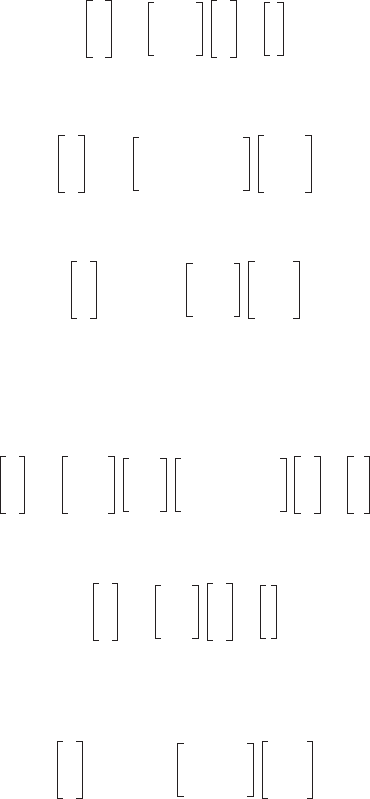
53-26 The Civil Engineering Handbook, Second Edition
or
(53.109c)
or
(53.109d)
The inverse transformation is given by
(53.109e)
or
(53.109f)
This transformation has four parameters: a uniform scale, a rotation, and two translations. It is a
conformal transformation.
Six-Parameter Transformation.
(53.110a)
or
(53.110b)
The six parameters of this transformation consist of two scales, one skew factor (lack of perpendicularity
of the axes), one rotation, and two shifts. The inverse transformation is given by
(53.110c)
Three-Dimensional Linear Transformations
As in the two-dimensional case, affine transformation in three dimensions can be factored out in several
elementary transformations: translation, uniform scale, nonuniform scale, rotations, reflections, etc.
Consideration, however, is limited to the seven-parameter transformation, which is composed of a
uniform scale change, three translations, and three rotations.
We first consider rotations in three-dimensional space.
Rotations of a Three-Dimensional Coordinate System. There are three elementary rotations, one about
each of the three axes. They are frequently performed in sequence one after the other. A set of three of
these is as follows, where x is the original system, x¢ is once rotated, and x≤ is twice rotated:
y
1
ax
1
bx
2
c
y
2
b– x
1
ax
2
d++=
++=
y
1
y
2
a b
b – a
x
1
x
2
c
d
+=
x
1
x
2
1
u
---
b
cos
b
sin–
b
sin
b
cos
y
1
c–
y
2
d–
=
x
1
x
2
1
a
2
b
2
+
----------------
a b–
b a
y
1
c–
y
2
d–
=
y
1
y
2
s
1
0
0 s
2
1 k
0 1
b
cos
b
sin
b
sin–
b
cos
x
1
x
2
t
1
t
2
+=
y
1
y
2
a b
d e
x
1
x
2
c
f
+=
x
1
x
2
1
ae bd–
-----------------
e b–
d– a
y
1
c–
y
2
f–
=
© 2003 by CRC Press LLC
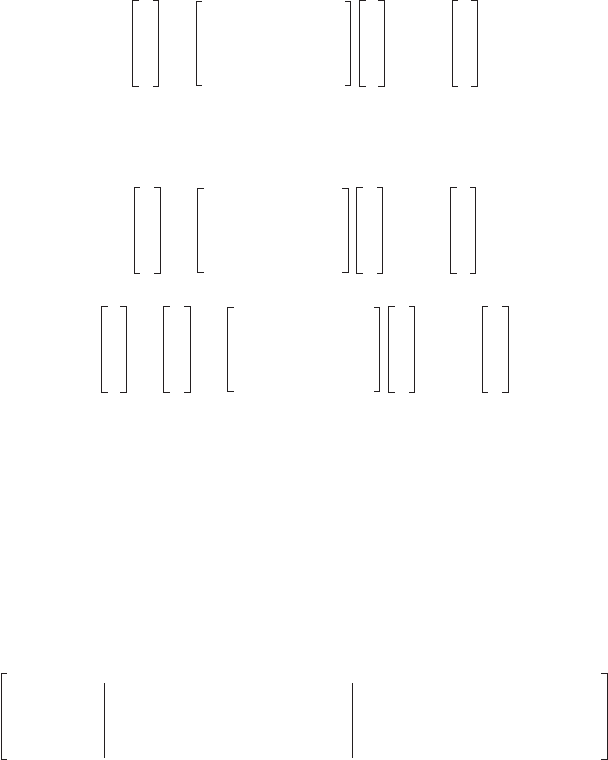
General Mathematical and Physical Concepts 53-27
1. b
1
about x
1
axis, positive rotation advances +x
2
to +x
3
2. b
2
about x¢
2
axis, positive rotation advances +x¢
3
to +x¢
1
3. b
3
about x≤
3
axis, positive rotation advances +x≤
1
to +x≤
2
Each of the three elementary rotations is represented in matrix form by
(53.111a)
where x
1
, x
2
, x
3
are the coordinates before rotation and x¢
1
, x¢
2
, x ¢
3
are the coordinates after rotation.
Similarly, rotations of +b
2
about the x ¢
2
axis and +b
3
about the x≤
3
axis are given by
(53.111b)
(53.111c)
The three rotations in Eq. (53.111) are often referred to as elementary rotations, since they may be
used to construct any required set of sequential rotations. By successive substitution, the total rotation
matrix is obtained:
(53.112)
in which M is now a function of the three rotation angles b
1
, b
2
, b
3
. The most commonly used set of
sequential rotations (in photogrammetry) is given the symbols w, f, k where w ∫ b
1
; f ∫ b
2
; k ∫ b
3
. In this
case, the matrix M which rotates the object coordinate system (X, Y, Z) parallel to the photo coordinate
system (x, y, z) is given by
(53.113)
in which w is about the X axis, f is about the once-rotated Y axis, and k is about the twice-rotated Z
axis. The matrix M is orthogonal, since M
w
, M
f
, and M
k
are each orthogonal.
Seven-Parameter Transformation. This transformation contains seven parameters: a uniform scale
change u, three rotations b
1
, b
2
, b
3
, and three translations t
1
, t
2
, t
3
. It takes the general form
y = uMx + t (53.114)
The orthogonal matrix M is a function of only three independent parameters, in this case the angles
b
1
, b
2
, b
3
. This transformation is useful for different applications, such as absolute orientation, model
connection, etc.
The orthogonal matrix M may be constructed by other methods besides sequential rotations. Two
such methods follow.
x
1
¢
x
2
¢
x
3
¢
10 0
0
b
1
cos
b
1
sin
0
b
1
sin–
b
1
cos
x
1
x
2
x
3
M
b
1
x
1
x
2
x
3
==
x
1
≤
x
2
≤
x
3
≤
b
2
cos 0
b
2
sin–
0 1 0
b
2
sin 0
b
1
cos
x
1
¢
x
2
¢
x
3
¢
M
b
2
x
1
x
2
x
3
==
y
1
y
2
y
3
x
1
≤¢
x
2
≤¢
x
3
≤¢
b
3
cos
b
3
sin 0
b
3
sin–
b
3
cos 0
00 1
x
1
≤
x
2
≤
x
3
≤
M
b
3
x
1
≤
x
2
≤
x
3
≤
== =
yx
≤¢
M
b
3
M
b
2
M
b
1
xMx== =
M
fk
coscos
fk
sincos–
f
sin
wk
wfk
cossinsin+sincos
wk
wfk
sinsinsin–coscos
w
sin– fcos
w
sin
k
w
cos
fk
cossin–sin
w
sin
k
w
cos
fk
sinsin+cos
wf
coscos
=
© 2003 by CRC Press LLC
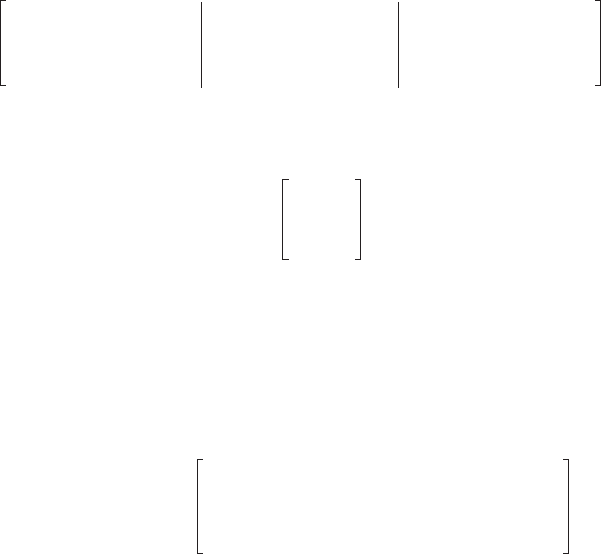
53-28 The Civil Engineering Handbook, Second Edition
Constructing M by One Rotation about a Line. This is also often referred to as the solid body rotation.
Given a three-dimensional object in two different orientations, there exists a line in space about which
the object may be rotated by a finite angle to change it from one orientation to the other. If the said line
has l, m, n as direction cosines and the angle of rotation is designated by a, the rotation matrix is given by
(53.115)
A Purely Algebraic Derivation of M. The following skew-symmetric matrix contains only three param-
eters a, b, c:
(53.116a)
An orthogonal matrix M can be obtained from M using
(53.116b)
in which M is the identity matrix. Then
(53.117)
Nonlinear Transformations
In addition to the linear transformations discussed so far, we use nonlinear transformations both in two
and three dimensions. In two dimensions we have the following two transformations:
Eight-Parameter Transformation. The equations
(53.118a)
represent the projective transformation from the x to the y coordinate systems, with the eight transfor-
mation parameters being a
0
, b
0
, a
1
, …, c
2
. Its inverse is given by
(53.118b)
These equations describe the central projectivity between two planes.
M
l
2
1
a
cos–()
a
cos+
lm
1
a
cos–()
na
sin+
ln
1
a
cos–()
ma
sin–
lm
1
a
cos–()
na
sin–
m
2
1
a
cos–()
a
cos+
mn
1
a
cos–()l
a
sin+
ln
1
a
cos–()m
a
sin+
mn
1
a
cos–()
la
sin–
n
2
1
a
cos–()
a
cos+
=
S
0 c– b
c 0 a–
b– a 0
=
MIS+()IS–()
1–
IS–()
1–
IS+()==
MIS–()
1–
IS+()=
1
1 a
2
b
2
c
2
+++
-----------------------------------
1 a
2
b
2
– c
2
–+ 2ab 2c– 2ac 2b+
2ab 2c+ 1 a
2
– b
2
c
2
–+ 2bc 2a–
2ac 2b– 2bc 2a + 1 a
2
– b
2
– c
2
+
=
y
1
a
1
x
1
b
1
x
2
c
1
++
a
0
x
1
b
0
x
2
1++
------------------------------------=
y
2
a
2
x
1
b
2
x
2
c
2
++
a
0
x
1
b
0
x
2
1++
------------------------------------=
x
1
c
1
y
1
–()b
0
y
2
b
2
–()c
2
y
2
–()b
0
y
1
b
1
–()–
a
0
y
1
a
1
–()b
0
y
2
b
2
–()a
2
y
2
a
2
–()b
0
y
1
b
1
–()–
------------------------------------------------------------------------------------------------------------=
x
2
a
0
y
1
a
1
–()c
2
y
2
–()a
0
y
2
a
2
–()c
1
y
1
–()–
a
0
y
1
a
1
–()b
0
y
2
b
2
–()a
0
y
2
a
2
–()b
0
y
1
b
1
–()–
------------------------------------------------------------------------------------------------------------=
© 2003 by CRC Press LLC

General Mathematical and Physical Concepts 53-29
Tw o-Dimensional General Polynomials.
(53.119a)
These polynomials can obviously be extended to higher powers in x
1
, x
2
. A special case of these is the
conformal form given in the following section.
Tw o-Dimensional Conformal Polynomials. The conformal property preserves the angles between inter-
secting lines after the transformation. If we impose the two conditions
(53.119b)
on the general polynomials in Eq. (53.119a), we get
(53.119c)
Note that the first three terms after the equal signs are the same as those in the four-parameter
transformation given in Eq. (53.109c). Equation (53.119c) can also be derived using complex numbers
by writing
in which . Expanding and equating y
1
to the real part and y
2
to the imaginary part (multiplier
of i) on the right-hand side leads to Eq. (53.119c).
Three-dimensional General Polynomials.
(53.120a)
We can extend these polynomials to higher order. Unlike the two-dimensional case, conformal trans-
formation does not exist in three dimensions beyond the first-order (or linear) case given by the seven-
parameter transformation, Eq. (53.114). A close approximation, which exists for only second-degree
terms, is derived by imposing conditions similar to those in Eq. (53.119b) on every pair of coordinates
in Eq. (53.120a). This makes the projections of the 3-space onto each of the three planes conformal.
Thus, imposing the following on the general polynomials in Eq. (53.120a)
(53.120b)
leads to
(53.120c)
y
1
a
0
a
1
x
1
a
2
x
2
a
3
x
1
x
2
a
4
x
1
2
a
5
x
2
2
L+++ +++=
y
2
b
0
b
1
x
1
b
2
x
2
b
3
x
1
x
2
b
4
x
1
2
b
5
x
2
2
L+++ +++=
∂
y
1
∂
x
1
--------
∂
y
2
∂
x
2
--------
and
∂
y
1
∂
x
2
--------
∂
y
2
∂
x
1
--------–==
y
1
A
0
A
1
x
1
A
2
x
2
A
3
x
1
2
x
2
2
–()A
4
2x
1
x
2
()L+++ + +=
y
2
B
0
A
2
x
1
– A
1
x
2
A
4
x
1
2
x
2
2
–()– A
3
2x
1
x
2
()L+++=
y
1
y
2
i+()a
0
b
0
i+()a
1
b
1
i+()x
1
x
2
i+()a
3
b
3
i+()x
1
x
2
i+()
2
L++ +=
i 1–=
y
1
a
0
a
1
x
1
a
2
x
2
a
3
x
3
a
4
x
1
2
a
5
x
2
2
a
6
x
1
x
2
a
7
x
2
x
3
a
8
x
1
x
3
L++++++ + + +=
y
2
b
0
b
1
x
1
b
2
x
2
b
3
x
3
b
4
x
1
2
b
5
x
2
2
b
6
x
1
x
2
b
7
x
2
x
3
b
8
x
1
x
3
L++++++ + + +=
y
3
c
0
c
1
x
1
c
2
x
2
c
3
x
3
c
4
x
1
2
c
5
x
2
2
c
6
x
1
x
2
c
7
x
2
x
3
c
8
x
1
x
3
L++++++ + + +=
∂
y
1
∂
x
1
--------
∂
y
2
∂
x
2
--------
∂
y
3
∂
x
3
--------==
∂
y
1
∂
x
2
--------
∂
y
2
∂
x
1
--------
∂
y
2
∂
x
3
--------
;–
∂
y
3
∂
x
2
--------
∂y
1
∂x
3
--------
;–
∂
y
3
∂
x
1
--------–===
y
1
A
0
Ax
1
Bx
2
Cx
3
– Ex
1
2
x
2
2
– x
3
2
–()02Gx
3
x
1
2Fx
1
x
2
L++ + ++ + +=
y
2
B
0
Bx
1
– Ax
2
Dx
3
Fx
1
2
– x
2
2
x
3
2
–+()2Gx
2
x
3
02Ex
1
x
2
L+++ + ++ +=
y
3
C
0
Cx
1
Dx
2
– Ax
3
Gx
1
2
– x
2
2
– x
3
2
+()2Fx
2
x
3
2Ex
3
x
1
0 L+++ ++++=
© 2003 by CRC Press LLC
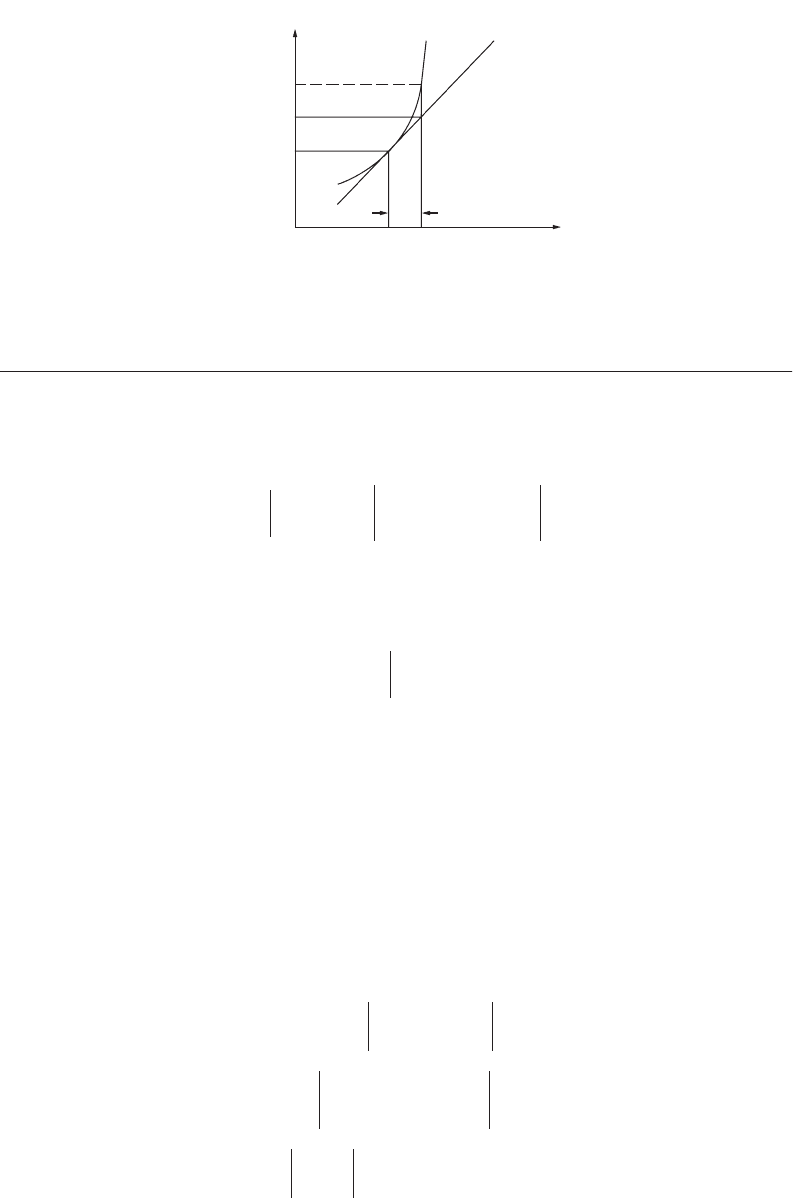
53-30 The Civil Engineering Handbook, Second Edition
53.7 Linearization of Nonlinear Functions
Frequently, the equations expressing the geometric and physical conditions of a problem are nonlinear,
which makes their direct solution difficult and uneconomical. We linearize these equations using series
expansion, usually Taylor’s series, which in general is given by the following for y = f (x):
(53.121)
This gives the value of y at (x
0
+ Dx), given the value of the function f (x
0
) at x
0
. Equation (53.121)
includes still higher-order terms, and therefore we usually drop the second- and higher-order terms and
use the approximation
(53.122)
with obvious correspondence in terms.
The technique of linearization is demonstrated in Fig. 53.4. The curve represents the original nonlinear
function f(x), whereas the straight line represents the linearized form, Eq. (53.122).
That line is tangent to the curve at the given point a, (x
0
, y
0
). When Dx is given (or evaluated), the
value of the function would be approximated by point b, whose ordinate is (y
0
+ jDx), and the exact value
from the nonlinear function is point c, with ordinate f (x
0
+ Dx). The error arising from using the linear
form is the line segment bc.
One Function of Two Variables
(53.123)
FIGURE 53.4 Linearization.
y
x
y
=
f
(
x
)
y
=
y
0
+
j
∆
x
(
y
0
+
j
∆
x
)
f
(
x
0
+ ∆
x
)
y
0
x
0
c
b
a
∆
x
yfx
0
()
df
dx
------
x
0
Dx
1
2!
----
d
2
y
dx
2
--------
x
0
Dx()
2
L
1
n!
-----
d
n
y
dx
n
--------
x
0
Dx()
n
L++ ++ +=
yfx
0
()
dy
dx
------
x
0
+ªDxy
0
jDx+ª
yfx
1
x
2
,()=
fx
1
0
x
2
0
,()
∂
y
∂
x
1
--------
x
1
0
x
2
0
,
Dx
1
∂
y
∂
x
2
--------
x
1
0
x
2
0
,
Dx
2
++=
1
2!
----
∂
2
y
∂
x
1
2
--------
x
1
0
x
2
0
,
Dx
1
()
2
1
2!
----
∂
2
y
∂
x
2
2
--------
x
1
0
x
2
0
,
Dx
2
()
2
++
∂
y
∂
x
1
--------
x
1
0
x
2
0
,
∂
y
∂
x
2
--------
x
1
0
x
2
0
,
Dx
1
()Dx
2
()L++
© 2003 by CRC Press LLC

General Mathematical and Physical Concepts 53-31
For the linearized form, Eq. (53.123) is truncated to
(53.124)
where
Equation (53.124) can be rewritten in matrix form as
or
(53.125)
where
is the Jacobian of y with respect to x.
Two Functions of One Variable
(53.126)
or
with
Two Functions of Two Variables Each
(53.127a)
or
(53.127b)
or
(53.127c)
yy
0
j
1
Dx
1
j
2
Dx
2
++=
y
0
fx
1
0
x
2
0
,() j
1
∂
y
∂
x
1
--------
x
1
0
x
2
0
,
j
2
∂
y
∂
x
2
--------
x
1
0
x
2
0
,
===
yy
0
j
1
j
2
[]
Dx
1
D x
2
+=
yy
0
J
yx
Dx+=
J
yx
∂
y
∂
x
------
∂
y
∂
x
1
--------
∂
y
∂
x
2
--------
==
y
1
f
1
x() y
1
0
j
1
Dx+ª=
y
2
f
2
x() y
2
0
j
2
Dx+ª=
yy
0
J
yx
Dx+=
y
1
0
f
1
x
0
()=
y
2
0
f
2
x
0
()=
J
yx
j
1
j
2
[]
T
dy
1
dx
-------
x
0
dy
2
dx
-------
x
0
T
==
y
1
f
1
x
1
x
2
,()y
1
0
j
11
Dx
1
j
12
Dx
2
++ª=
y
2
f
2
x
1
x
2
,()y
2
0
j
21
Dx
1
j
22
Dx
2
++ª=
y
1
y
2
y
1
0
y
2
0
j
11
j
12
j
21
j
22
Dx
1
Dx
2
+ª
yy
0
J
yx
Dx+=
© 2003 by CRC Press LLC
